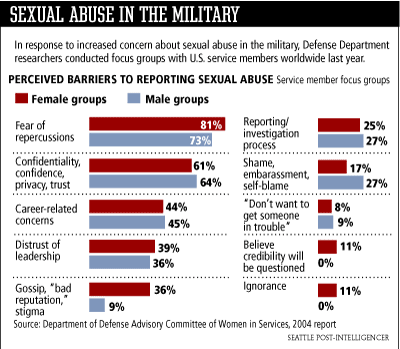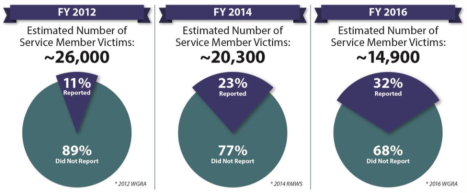There are over 200,000 active-duty servicewomen comprising 14.5% of the total active force of 1.4 million people.
Recently (in part because of the reluctance of some in Congress to renew the Violence Against Women Act), more attention has been given to the rampant sexual abuse of both women and men in the military.
For example, The New York Times recently ran a harrowing story featuring one of the SIXTY-TWO trainees at Lackland Air Force Base who were victims of assault or other improper conduct by THIRTY-TWO training instructors between 2009 and 2012. Virginia Messick was unable to complain to her superior, because her superior was the one who raped her.
A 2015 study, which was conducted by the RAND corporation and sponsored by the Pentagon, indicated that an estimated 18,900 soldiers, sailors, Marines and Air Force personnel said they were victims of “unwanted sexual contact” in the 2014 fiscal year. (In the surveys, the Pentagon uses the words “unwanted sexual contact” as an umbrella term covering any sexual offense, from inappropriate touching to rape.) This was considered to be good thing, since it compared favorably to the 2012 report of 26,000 military personnel.
This also differs from the official report of the Department of Defense issued in 2015 which gave a number of “only” 6,083 reports of sexual assault for the Fiscal year 2015. (It should also be noted that their figures for “sexual assault” did not include reports of “sexual harassment.” They cite a the figure of 657 formal complaints for this in 2015.) Unveiling the Annual Report on Sexual Assault in the Military for Fiscal Year 2016, Navy Rear Adm. Ann M. Burkhardt, director of DoD’s Sexual Assault Prevention and Response Office, said the report showed 14,900 service members were sexually assaulted in 2016, which is 5,400 fewer than the 20,300 sexual assault victim reports estimated in 2014.
The fiscal 2016 report also shows that one in three service members chose to report their assaults in 2016, which is increased from one in four people in 2014, Burkhardt said, noting that 10 years ago only one in 14 service members reported the crime.
There are a number of factors militating against reporting such incidents, as shown graphically below:
Moreover, it is not as if subjecting oneself to the horrible experience of testifying has positive results. The Military Times reported in 2015:
Last year, 6,131 service members reported a sexual assault.
But only about 317 service members were court-martialed and sentenced to confinement as a result of a reported sexual assault.
The dizzying details underlying that roughly 1-in-20 conviction-and-incarceration rate were buried in the latest annual military sexual assault report released May 1, which reveals how sexual assault complaints were handled by criminal investigators and commanders.”
Retaliation by the military against those who report sexual assaults is an ongoing problem. Human Rights Watch also has condemned the military for this practice.
Documented psychological consequences of military sexual trauma (MST) most frequently include PTSD, impairments of social functioning and quality of life (for example, a study found that more than fifty percent of homeless female veterans had experienced military sexual trauma), chronic pain, suicidal thoughts and suicide attempts.
The Department of Defense, however, claims their investigation process is satisfactory, and that “The Department takes appropriate action in every case where it has jurisdiction and the evidence to do so.”:
This is not the impression one gets either from perusing the trauma experienced by victims, or the figures revealing how many victims do not come forward, although the numbers do seem to be getting better.
Nor does it square with the anecdotal reports of those brave enough to go to the media. Nicole McCoy, for example, who was assaulted several times while in the Marines, said in an NPR interview that her bad experiences started soon after she signed up:
Back in 2008, I had joined the Marine Corps and within almost exactly a year I was raped while in Afghanistan while I was at work. Continuously had to work with the same guy. He held a 9 millimeter to my head and told me that if I told anyone he’d kill me. And then I left Afghanistan after a couple months, still never told anyone.”
Her story just gets worse:
…in January of 2010 I was raped while in a hazmat course. And I went back and told one of the Marines that I was there with and I had told him what happened. He said he would contact my staff NCO. The staff NCO told me I needed to wait until I got back to my duty station, as they didn’t have any uniform victim advocates where I was. So when I got back then they told me that I missed the deadline.”
And believe it or not, the abuse continued. She finally left the Corps in 2011. Now she works as an advocate for change in the military and works to support other victims. But it’s an uphill road. As another female vet, Julie, testified on the same show:
I’m a Vietnam-era vet, and I joined in 1973, and like Nicole, I had multiple experiences with sexual assault. And let me be very clear here: I don’t feel that I’m a victim. This is something that happens to us in the military, because quite often the war that we have is with the guy standing next to us, not necessarily the guy on the other side of the gun.
And let me make a point that I’m not hearing being made: Rank has its privileges, gentlemen, and one of the most important aspects of this argument is that power – power over women is a very, very heady thing in the military. The men who attacked me had rank, and as an enlisted woman, and I wasn’t an enlisted woman the entire time I was in, they had power over me because they had rank. And I did not feel at the time of these assaults that I had the right to make an appeal to anybody else, that I felt that I would have been run out of the Army, and I’d made a commitment to my country.
So I bit on a stick. I kept walking. I didn’t make any appeal, and I simply was the good soldier. And one of the most important aspects of this, and the fundamental problem is that it starts at the top, and – may I point out Petraeus. These guys cannot keep it zipped up. It is at the very, very top ranks. This is an issue of power and the permission to do whatever they want because it comes with rank.”
Read the whole transcript here. And help fight the lack of prosecutions! If there is no punishment, there is no incentive not to continue.
Additional data on sexual assaults in the military is presented in this 2015 article. You can also refer to this “Quick Fact Sheet” about military sexual abuse here. This fact sheet is made available by Protect Our Defenders (POD), the only national organization solely dedicated to ending the epidemic of rape and sexual assault in the military and to combating a culture of pervasive sexual harassment and retribution against victims. There are a number of excellent resources on their website.
The Washington Post also recently ran a horrifying story about sexual abuse of women at the Virginia Military Institute, here.
[It should be noted, as indicated above, that while women make up the overwhelming number of victims, sexual abuse is not confined to them. You can read more about sexual assaults of men in the military here.] The Department of Defense shows these statistics:










Leave a comment